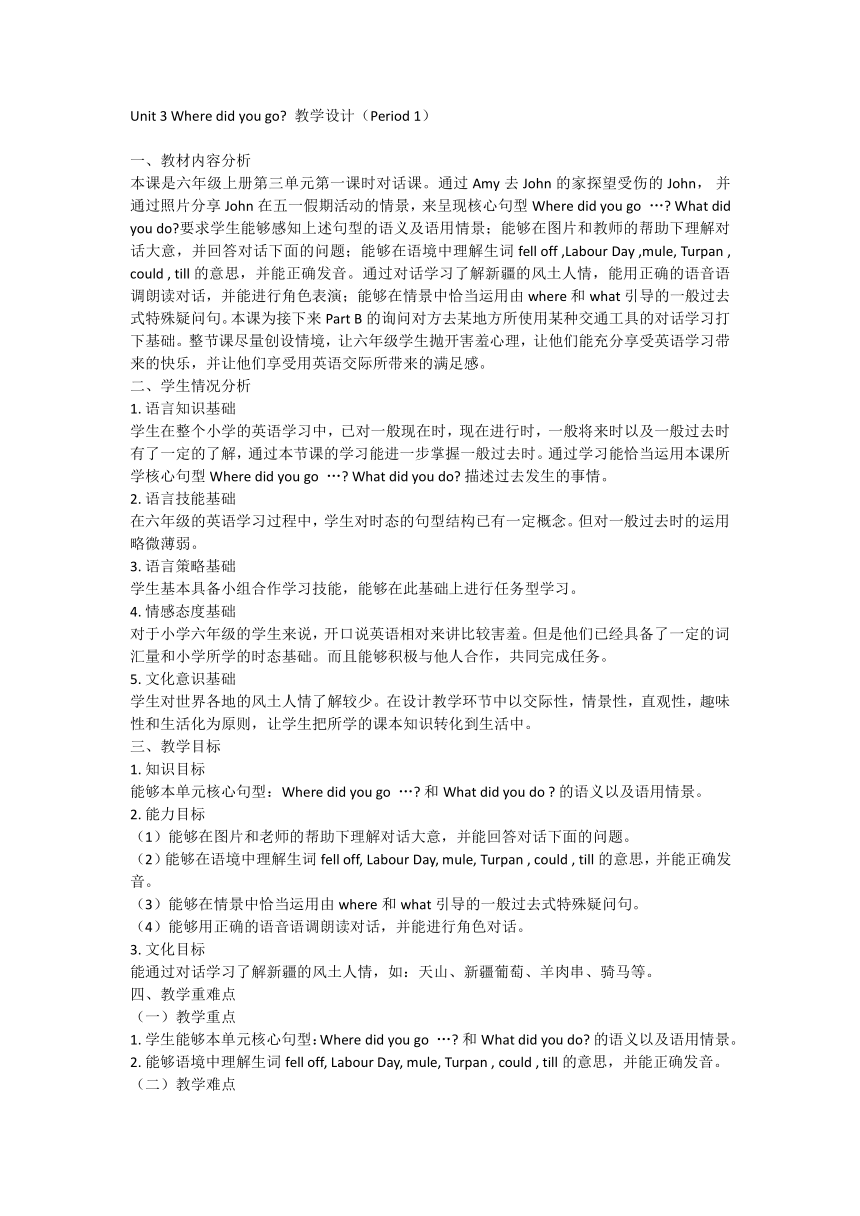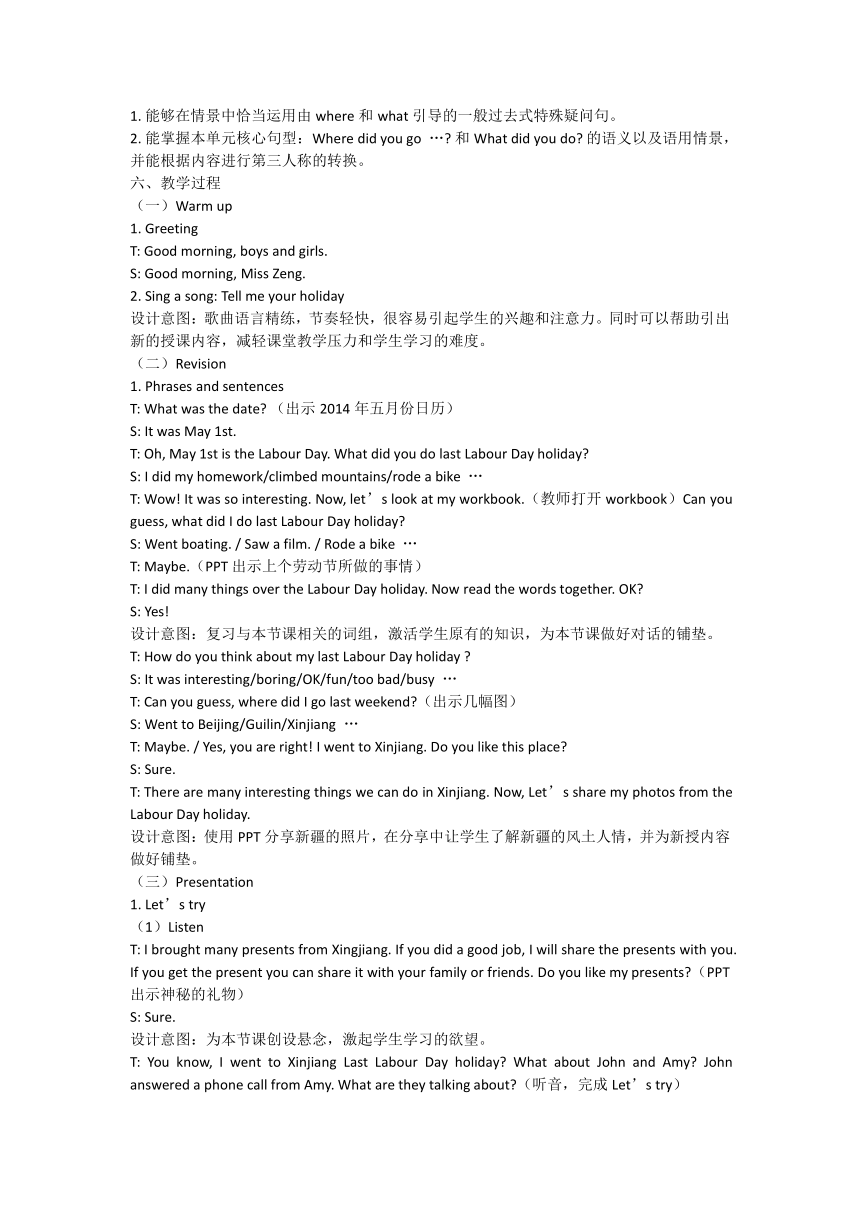Unit 3 Where did you go? Let’s talk 教案
文档属性
| 名称 | Unit 3 Where did you go? Let’s talk 教案 |

|
|
| 格式 | zip | ||
| 文件大小 | 15.9KB | ||
| 资源类型 | 教案 | ||
| 版本资源 | 人教版(PEP) | ||
| 科目 | 英语 | ||
| 更新时间 | 2022-05-30 15:23:37 | ||
图片预览


文档简介
Unit 3 Where did you go 教学设计(Period 1)
一、教材内容分析
本课是六年级上册第三单元第一课时对话课。通过Amy去John的家探望受伤的John, 并通过照片分享John在五一假期活动的情景,来呈现核心句型Where did you go … What did you do 要求学生能够感知上述句型的语义及语用情景;能够在图片和教师的帮助下理解对话大意,并回答对话下面的问题;能够在语境中理解生词fell off ,Labour Day ,mule, Turpan , could , till 的意思,并能正确发音。通过对话学习了解新疆的风土人情,能用正确的语音语调朗读对话,并能进行角色表演;能够在情景中恰当运用由where 和what引导的一般过去式特殊疑问句。本课为接下来Part B的询问对方去某地方所使用某种交通工具的对话学习打下基础。整节课尽量创设情境,让六年级学生抛开害羞心理,让他们能充分享受英语学习带来的快乐,并让他们享受用英语交际所带来的满足感。
二、学生情况分析
1. 语言知识基础
学生在整个小学的英语学习中,已对一般现在时,现在进行时,一般将来时以及一般过去时有了一定的了解,通过本节课的学习能进一步掌握一般过去时。通过学习能恰当运用本课所学核心句型Where did you go … What did you do 描述过去发生的事情。
2. 语言技能基础
在六年级的英语学习过程中,学生对时态的句型结构已有一定概念。但对一般过去时的运用略微薄弱。
3. 语言策略基础
学生基本具备小组合作学习技能,能够在此基础上进行任务型学习。
4. 情感态度基础
对于小学六年级的学生来说,开口说英语相对来讲比较害羞。但是他们已经具备了一定的词汇量和小学所学的时态基础。而且能够积极与他人合作,共同完成任务。
5. 文化意识基础
学生对世界各地的风土人情了解较少。在设计教学环节中以交际性,情景性,直观性,趣味性和生活化为原则,让学生把所学的课本知识转化到生活中。
三、教学目标
1. 知识目标
能够本单元核心句型:Where did you go … 和What did you do 的语义以及语用情景。
2. 能力目标
(1)能够在图片和老师的帮助下理解对话大意,并能回答对话下面的问题。
(2)能够在语境中理解生词fell off, Labour Day, mule, Turpan , could , till的意思,并能正确发音。
(3)能够在情景中恰当运用由where和what引导的一般过去式特殊疑问句。
(4)能够用正确的语音语调朗读对话,并能进行角色对话。
3. 文化目标
能通过对话学习了解新疆的风土人情,如:天山、新疆葡萄、羊肉串、骑马等。
四、教学重难点
(一)教学重点
1. 学生能够本单元核心句型:Where did you go … 和What did you do 的语义以及语用情景。
2. 能够语境中理解生词fell off, Labour Day, mule, Turpan , could , till的意思,并能正确发音。
(二)教学难点
1. 能够在情景中恰当运用由where和what引导的一般过去式特殊疑问句。
2. 能掌握本单元核心句型:Where did you go … 和What did you do 的语义以及语用情景,并能根据内容进行第三人称的转换。
六、教学过程
(一)Warm up
1. Greeting
T: Good morning, boys and girls.
S: Good morning, Miss Zeng.
2. Sing a song: Tell me your holiday
设计意图:歌曲语言精练,节奏轻快,很容易引起学生的兴趣和注意力。同时可以帮助引出新的授课内容,减轻课堂教学压力和学生学习的难度。
(二)Revision
1. Phrases and sentences
T: What was the date (出示2014年五月份日历)
S: It was May 1st.
T: Oh, May 1st is the Labour Day. What did you do last Labour Day holiday
S: I did my homework/climbed mountains/rode a bike …
T: Wow! It was so interesting. Now, let’s look at my workbook.(教师打开workbook)Can you guess, what did I do last Labour Day holiday
S: Went boating. / Saw a film. / Rode a bike …
T: Maybe.(PPT 出示上个劳动节所做的事情)
T: I did many things over the Labour Day holiday. Now read the words together. OK
S: Yes!
设计意图:复习与本节课相关的词组,激活学生原有的知识,为本节课做好对话的铺垫。
T: How do you think about my last Labour Day holiday
S: It was interesting/boring/OK/fun/too bad/busy …
T: Can you guess, where did I go last weekend (出示几幅图)
S: Went to Beijing/Guilin/Xinjiang …
T: Maybe. / Yes, you are right! I went to Xinjiang. Do you like this place
S: Sure.
T: There are many interesting things we can do in Xinjiang. Now, Let’s share my photos from the Labour Day holiday.
设计意图:使用PPT分享新疆的照片,在分享中让学生了解新疆的风土人情,并为新授内容做好铺垫。
(三)Presentation
1. Let’s try
(1)Listen
T: I brought many presents from Xingjiang. If you did a good job, I will share the presents with you. If you get the present you can share it with your family or friends. Do you like my presents (PPT出示神秘的礼物)
S: Sure.
设计意图:为本节课创设悬念,激起学生学习的欲望。
T: You know, I went to Xinjiang Last Labour Day holiday What about John and Amy John answered a phone call from Amy. What are they talking about (听音,完成Let’s try)
(2)Listen and tick or cross
The second class is beginning.
John is at home.
John hurt his foot.
T: Oh, I see. John hurt his foot. Can you tell me what happened
设计意图:整合教材Let’s try板块作为导入,以培养学生的思维能力,并为Let’s talk的输入做好铺垫。
2. Listen and read
Let’s talk课文配套光盘出示。
(1)Watch the vedio.(整体感知,带着问题听对话)
①Why did John hurt his foot
A: Fell off his bike.
B: Fell off his horse.
②Where did John go over his holiday
A: Went to Beijing.
B: Went to Xinjiang.
③What did he do on the Labour Day holiday
A: Rode a horse.
B: Rode a bike.
④Did he like Turpan
A: Yes, he did.
B: No, he didn’t.
设计意图:让学生带着问题听课文可以更好地理解文本的大意。
(2)Read after the compute
全班跟读,在跟读中解决单词: happened/Labour Day rode a horse/mule/Turpan ...
(3)Read after the computer
分角色跟读
设计意图:通过层层递进的活动,帮助学生模仿读音,理解对话内容,同时培养了学生的读音技巧。
(四)Practice
1. Self-practice
T: Let’s read the dialogue in pairs. One is Amy, one is John.(读者剧场,教师指导)
2. Show
教师请两组学生到台前表演各组练习的对话。
3. Analysis
(1)Order
T: Look at these sentences and make a dialogue with your partner. Now, take out your paper and do it, please.(学生拿出对话材料,发挥同桌之间的合作精神,把下列句子重新编成一个完整,通顺的对话)
(2)Check together
教师请一组学生汇报自己组的练习结果。
T: Are they all right
S: Yes. / No.
T: Now, Let’s check the answers.(点击PPT)
(3)Read together
设计意图:把教材本来的内容进行重新构建,使它形成一个具有情景和现实可操作意义的独立的文本语段。将文本向学生的学靠拢。
(4)Open questions
①Is Xinjiang a beautiful place Why do you think so
②Do you like the Labour Day holiday Why
设计意图:采用开放性问题,不但可以培养学生的思维能力,贴近学生真实的生活,而且能引起学生学习的兴趣,调动学生参与活动的积极性。
(5)Emphasis
T: OK, I like the Labour Day holiday, too. Because I can go on a big trip. And I can see many beautiful place. What about your last Labour Day holiday
T: Where did you go over your Labour Day holiday (板书)
S: I went to …
T: What did you do (板书)
S: I went swimming/rode a horse/rode a bike …
(6)Sentence practice
教师出示一些图片让学生操练句型。(师生示范、生生操练、学生表演)
(7)知识过渡
教师请几组学生回答后引导学生过度到第三人称的用法并板书:
Where did he/she go What did he/she do
He/She went to … He/She rode a horse …
(8)Play a game: Happy time
PPT出示一个转盘,转盘里分成若干份,每份有表示地点,事情和交通工具的图片,转到指针所指的图片进行对话。
Example:
A: How was your Labour Day holiday
B: It was fine/interesting/boring/OK …
A: Where did you go
B: I went to …
A: How did you go there
B: I went by …
A: What did you do there
B: I climbed mountains …
设计意图:根据本节课所学内容,巧妙运用转盘的游戏,让学生能在玩中学,学中玩,从而更好地突破教学重难点。
T: Wow! It’s so interesting. Now choose the sentences and make a dialogue with them.(出示半控制性问题让学生选择自己喜欢的内容角色,选择下列句子编一个完整通顺的对话。
Amy John
(9)Now, talk about your weekend
教师鼓励学生多用语言作表述,说得越多句子所得的礼物就越多。
设计意图:以教材为语量基础,从学生个人的实际情况出发,采用奖励的方法进行层层递进,鼓励学生多用语言将教学内容进行重构,让英语课堂回到学生的真实生活中来。
(五)Summary
(六)Homework
1. Talking about your last weekend with parents.
2. Share is a happy. So if you get the presents , share it with your family or friends,please.
设计意图:延伸和拓展传统的英语教学,使学生将学会的英语语言知识运用到实际生活中,让他们走出了课堂也能体会到成功的喜悦,并让孩子们明白分享也是一种快乐。
一、教材内容分析
本课是六年级上册第三单元第一课时对话课。通过Amy去John的家探望受伤的John, 并通过照片分享John在五一假期活动的情景,来呈现核心句型Where did you go … What did you do 要求学生能够感知上述句型的语义及语用情景;能够在图片和教师的帮助下理解对话大意,并回答对话下面的问题;能够在语境中理解生词fell off ,Labour Day ,mule, Turpan , could , till 的意思,并能正确发音。通过对话学习了解新疆的风土人情,能用正确的语音语调朗读对话,并能进行角色表演;能够在情景中恰当运用由where 和what引导的一般过去式特殊疑问句。本课为接下来Part B的询问对方去某地方所使用某种交通工具的对话学习打下基础。整节课尽量创设情境,让六年级学生抛开害羞心理,让他们能充分享受英语学习带来的快乐,并让他们享受用英语交际所带来的满足感。
二、学生情况分析
1. 语言知识基础
学生在整个小学的英语学习中,已对一般现在时,现在进行时,一般将来时以及一般过去时有了一定的了解,通过本节课的学习能进一步掌握一般过去时。通过学习能恰当运用本课所学核心句型Where did you go … What did you do 描述过去发生的事情。
2. 语言技能基础
在六年级的英语学习过程中,学生对时态的句型结构已有一定概念。但对一般过去时的运用略微薄弱。
3. 语言策略基础
学生基本具备小组合作学习技能,能够在此基础上进行任务型学习。
4. 情感态度基础
对于小学六年级的学生来说,开口说英语相对来讲比较害羞。但是他们已经具备了一定的词汇量和小学所学的时态基础。而且能够积极与他人合作,共同完成任务。
5. 文化意识基础
学生对世界各地的风土人情了解较少。在设计教学环节中以交际性,情景性,直观性,趣味性和生活化为原则,让学生把所学的课本知识转化到生活中。
三、教学目标
1. 知识目标
能够本单元核心句型:Where did you go … 和What did you do 的语义以及语用情景。
2. 能力目标
(1)能够在图片和老师的帮助下理解对话大意,并能回答对话下面的问题。
(2)能够在语境中理解生词fell off, Labour Day, mule, Turpan , could , till的意思,并能正确发音。
(3)能够在情景中恰当运用由where和what引导的一般过去式特殊疑问句。
(4)能够用正确的语音语调朗读对话,并能进行角色对话。
3. 文化目标
能通过对话学习了解新疆的风土人情,如:天山、新疆葡萄、羊肉串、骑马等。
四、教学重难点
(一)教学重点
1. 学生能够本单元核心句型:Where did you go … 和What did you do 的语义以及语用情景。
2. 能够语境中理解生词fell off, Labour Day, mule, Turpan , could , till的意思,并能正确发音。
(二)教学难点
1. 能够在情景中恰当运用由where和what引导的一般过去式特殊疑问句。
2. 能掌握本单元核心句型:Where did you go … 和What did you do 的语义以及语用情景,并能根据内容进行第三人称的转换。
六、教学过程
(一)Warm up
1. Greeting
T: Good morning, boys and girls.
S: Good morning, Miss Zeng.
2. Sing a song: Tell me your holiday
设计意图:歌曲语言精练,节奏轻快,很容易引起学生的兴趣和注意力。同时可以帮助引出新的授课内容,减轻课堂教学压力和学生学习的难度。
(二)Revision
1. Phrases and sentences
T: What was the date (出示2014年五月份日历)
S: It was May 1st.
T: Oh, May 1st is the Labour Day. What did you do last Labour Day holiday
S: I did my homework/climbed mountains/rode a bike …
T: Wow! It was so interesting. Now, let’s look at my workbook.(教师打开workbook)Can you guess, what did I do last Labour Day holiday
S: Went boating. / Saw a film. / Rode a bike …
T: Maybe.(PPT 出示上个劳动节所做的事情)
T: I did many things over the Labour Day holiday. Now read the words together. OK
S: Yes!
设计意图:复习与本节课相关的词组,激活学生原有的知识,为本节课做好对话的铺垫。
T: How do you think about my last Labour Day holiday
S: It was interesting/boring/OK/fun/too bad/busy …
T: Can you guess, where did I go last weekend (出示几幅图)
S: Went to Beijing/Guilin/Xinjiang …
T: Maybe. / Yes, you are right! I went to Xinjiang. Do you like this place
S: Sure.
T: There are many interesting things we can do in Xinjiang. Now, Let’s share my photos from the Labour Day holiday.
设计意图:使用PPT分享新疆的照片,在分享中让学生了解新疆的风土人情,并为新授内容做好铺垫。
(三)Presentation
1. Let’s try
(1)Listen
T: I brought many presents from Xingjiang. If you did a good job, I will share the presents with you. If you get the present you can share it with your family or friends. Do you like my presents (PPT出示神秘的礼物)
S: Sure.
设计意图:为本节课创设悬念,激起学生学习的欲望。
T: You know, I went to Xinjiang Last Labour Day holiday What about John and Amy John answered a phone call from Amy. What are they talking about (听音,完成Let’s try)
(2)Listen and tick or cross
The second class is beginning.
John is at home.
John hurt his foot.
T: Oh, I see. John hurt his foot. Can you tell me what happened
设计意图:整合教材Let’s try板块作为导入,以培养学生的思维能力,并为Let’s talk的输入做好铺垫。
2. Listen and read
Let’s talk课文配套光盘出示。
(1)Watch the vedio.(整体感知,带着问题听对话)
①Why did John hurt his foot
A: Fell off his bike.
B: Fell off his horse.
②Where did John go over his holiday
A: Went to Beijing.
B: Went to Xinjiang.
③What did he do on the Labour Day holiday
A: Rode a horse.
B: Rode a bike.
④Did he like Turpan
A: Yes, he did.
B: No, he didn’t.
设计意图:让学生带着问题听课文可以更好地理解文本的大意。
(2)Read after the compute
全班跟读,在跟读中解决单词: happened/Labour Day rode a horse/mule/Turpan ...
(3)Read after the computer
分角色跟读
设计意图:通过层层递进的活动,帮助学生模仿读音,理解对话内容,同时培养了学生的读音技巧。
(四)Practice
1. Self-practice
T: Let’s read the dialogue in pairs. One is Amy, one is John.(读者剧场,教师指导)
2. Show
教师请两组学生到台前表演各组练习的对话。
3. Analysis
(1)Order
T: Look at these sentences and make a dialogue with your partner. Now, take out your paper and do it, please.(学生拿出对话材料,发挥同桌之间的合作精神,把下列句子重新编成一个完整,通顺的对话)
(2)Check together
教师请一组学生汇报自己组的练习结果。
T: Are they all right
S: Yes. / No.
T: Now, Let’s check the answers.(点击PPT)
(3)Read together
设计意图:把教材本来的内容进行重新构建,使它形成一个具有情景和现实可操作意义的独立的文本语段。将文本向学生的学靠拢。
(4)Open questions
①Is Xinjiang a beautiful place Why do you think so
②Do you like the Labour Day holiday Why
设计意图:采用开放性问题,不但可以培养学生的思维能力,贴近学生真实的生活,而且能引起学生学习的兴趣,调动学生参与活动的积极性。
(5)Emphasis
T: OK, I like the Labour Day holiday, too. Because I can go on a big trip. And I can see many beautiful place. What about your last Labour Day holiday
T: Where did you go over your Labour Day holiday (板书)
S: I went to …
T: What did you do (板书)
S: I went swimming/rode a horse/rode a bike …
(6)Sentence practice
教师出示一些图片让学生操练句型。(师生示范、生生操练、学生表演)
(7)知识过渡
教师请几组学生回答后引导学生过度到第三人称的用法并板书:
Where did he/she go What did he/she do
He/She went to … He/She rode a horse …
(8)Play a game: Happy time
PPT出示一个转盘,转盘里分成若干份,每份有表示地点,事情和交通工具的图片,转到指针所指的图片进行对话。
Example:
A: How was your Labour Day holiday
B: It was fine/interesting/boring/OK …
A: Where did you go
B: I went to …
A: How did you go there
B: I went by …
A: What did you do there
B: I climbed mountains …
设计意图:根据本节课所学内容,巧妙运用转盘的游戏,让学生能在玩中学,学中玩,从而更好地突破教学重难点。
T: Wow! It’s so interesting. Now choose the sentences and make a dialogue with them.(出示半控制性问题让学生选择自己喜欢的内容角色,选择下列句子编一个完整通顺的对话。
Amy John
(9)Now, talk about your weekend
教师鼓励学生多用语言作表述,说得越多句子所得的礼物就越多。
设计意图:以教材为语量基础,从学生个人的实际情况出发,采用奖励的方法进行层层递进,鼓励学生多用语言将教学内容进行重构,让英语课堂回到学生的真实生活中来。
(五)Summary
(六)Homework
1. Talking about your last weekend with parents.
2. Share is a happy. So if you get the presents , share it with your family or friends,please.
设计意图:延伸和拓展传统的英语教学,使学生将学会的英语语言知识运用到实际生活中,让他们走出了课堂也能体会到成功的喜悦,并让孩子们明白分享也是一种快乐。
